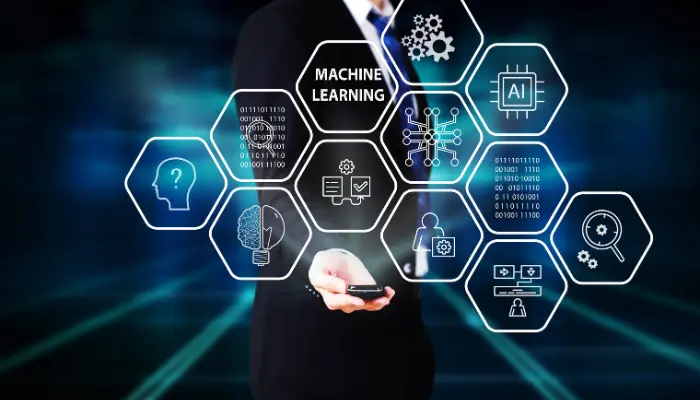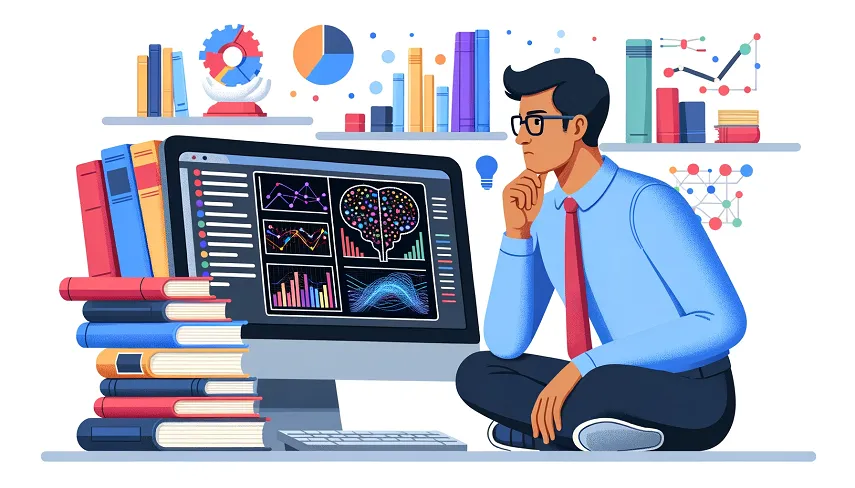Have you ever wondered how Netflix knows what movies you like? Or how your phone recognizes your face? This is machine learning at work. Understanding what is machine learning helps you see how computers get smarter every day.
Machine learning is like teaching a computer to think. But instead of giving it exact rules, we show it lots of examples. The computer learns patterns from these examples. Then it makes smart guesses about new things it has never seen before.
What Makes Machine Learning Special?

Understanding what is machine learning starts with knowing what makes it different. Regular computer programs follow exact steps. Machine learning programs learn from data and improve over time.
Think of it like learning to drive. You don’t memorize every possible road situation. Instead, you practice with different examples. You learn patterns. Then you handle new situations based on what you learned.
Here’s what machine learning can do:
- Learn from mistakes and get better each time
- Find hidden patterns in large amounts of data
- Make predictions about future events
- Work with different types of information like pictures and text
- Handle complex problems that have many variables
- Save time by doing tasks faster than humans
- Work without breaks around the clock
Main Parts of Machine Learning
Understanding what is machine learning means knowing its basic building blocks. Every machine learning system has three main parts.

Data: The Learning Material
Data is like textbooks for machine learning. The computer studies this information to learn patterns. Good data has these qualities:
- Enough examples to learn properly
- Clean information without errors
- Different types of examples
- Recent information that stays current
- Relevant details for the problem
Rules: The Learning Methods
Machine learning uses different methods to study data. These methods help computers find patterns and make decisions:
- Simple methods for basic problems
- Complex methods for harder challenges
- Step-by-step methods that ask questions
- Network methods that copy how brains work
- Group methods that put similar things together
Results: The Final Product
After learning from data, the computer creates a model. This model can make predictions about new information:
- Accuracy shows how often it’s right
- Speed tells how fast it works
- Reliability measures how consistent it is
- Simplicity means how easy it is to understand
- Flexibility shows how well it adapts to new situations
Three Ways Computers Learn
Understanding what is machine learning includes knowing the three main learning styles. Each style works differently and solves different problems.
Learning with Examples
This method uses examples with correct answers. It’s like studying for a test with answer sheets. The computer sees many examples and learns what the right answers look like.
Common uses include:
- Email sorting to find spam messages
- Photo recognition to identify objects
- Weather prediction using past weather data
- Price estimation for houses and cars
- Medical diagnosis based on symptoms
- Language translation between different languages
- Voice recognition to understand speech
Learning without Answers
This method finds patterns without knowing the right answers. It’s like sorting your closet without instructions. The computer groups similar things together.
Popular uses include:
- Customer grouping for better marketing
- Finding unusual behavior that might be fraud
- Organizing large databases into manageable groups
- Market research to understand buying patterns
- Gene research to find similar genetic codes
- Social media analysis to identify trending topics
- Quality control to spot defective products
Learning through Trial
This method learns by trying different actions and seeing what works. It’s like learning to play a game by playing many rounds. The computer gets rewards for good choices and penalties for bad ones.
Best applications include:
- Game playing where computers learn winning strategies
- Robot control for walking and moving
- Traffic management to reduce congestion
- Investment decisions in financial markets
- Resource planning for efficient operations
- Recommendation systems that improve over time
- Manufacturing optimization for better production
Popular Learning Methods
Understanding what is machine learning requires knowing the most common methods computers use to learn patterns and make decisions.
Decision Trees
Decision trees work like a flowchart. They ask simple yes-or-no questions to make decisions. Each question leads to another question or a final answer.
Benefits include:
- Easy to understand and explain to others
- Works with different types of information
- Handles missing information without problems
- Shows which factors are most important
- Makes quick decisions once trained
- Requires little preparation of data
Random Forest
Random forest combines many decision trees. It’s like asking many experts and taking their average opinion. This method is more accurate than using just one tree.
Advantages include:
- Better accuracy than single methods
- Less likely to make consistent errors
- Handles large amounts of data well
- Shows importance of different factors
- Works reliably with various problems
- Reduces overfitting to training examples
Support Vector Machines
This method finds the best line to separate different groups. Imagine drawing a line to separate apples from oranges on a table. The method finds the best possible line.
Strengths include:
- Works well with many dimensions
- Uses memory efficiently by focusing on key examples
- Handles different types of data relationships
- Performs well with smaller datasets
- Has strong mathematical foundations
- Provides reliable results consistently
Neural Networks
Neural networks copy how the human brain works. They have many connected nodes that process information together. Deep learning uses many layers of these nodes.
Capabilities include:
- Recognizes complex patterns in images and sounds
- Learns features automatically without human help
- Handles massive datasets efficiently
- Works across many different problem types
- Improves continuously with more data
- Adapts to new situations quickly
Real World Uses
Understanding what is machine learning becomes clearer when you see how it helps in everyday life. These examples show the practical benefits across different areas.
Healthcare Applications
Hospitals and doctors use machine learning to provide better care. These tools help save lives and improve treatment outcomes.
Medical uses include:
- Medical scans to spot diseases early
- Drug discovery to find new medicines faster
- Treatment planning based on patient history
- Health monitoring through wearable devices
- Surgery assistance with precise robotic help
- Mental health support through behavior analysis
- Emergency response for faster ambulance routing
Money and Banking
Banks use machine learning to protect customers and make better financial decisions. These systems work behind the scenes to keep your money safe.
Financial uses include:
- Credit scoring to decide loan approvals
- Fraud detection to stop suspicious transactions
- Trading systems that buy and sell stocks
- Insurance claims processing automatically
- Customer service through chat systems
- Risk assessment for investment decisions
- Budget planning tools for personal finance
Transportation Systems
Cars, trains, and delivery services use machine learning to move people and goods efficiently. These systems make travel safer and faster.
Transportation uses include:
- Self-driving cars that navigate roads safely
- Traffic control to reduce jams and delays
- Vehicle maintenance prediction before breakdowns
- Route planning for fastest delivery times
- Fuel efficiency optimization for lower costs
- Public transit scheduling based on demand
- Parking systems that find available spaces
Entertainment Platforms
Movies, music, and gaming platforms use machine learning to keep you entertained. These systems learn what you like and suggest similar content.
Entertainment uses include:
- Movie recommendations based on viewing history
- Music playlists that match your taste
- Game opponents that adjust to your skill level
- Content creation assistance for artists
- Social media feeds personalized for interests
- Video quality enhancement for better viewing
- Sports analysis for team strategy improvement
Benefits of Machine Learning
Understanding what is machine learning includes recognizing how it makes life better. These advantages help businesses serve customers better and solve complex problems.
Speed and Efficiency
Machine learning systems work much faster than humans for many tasks. They never get tired and can work continuously without breaks.
Speed benefits include:
- 24-hour operation without stopping
- Consistent performance that doesn’t vary
- Fast processing of huge amounts of data
- Quick responses to changing conditions
- Reduced waiting times for customers
- Lower operational costs through automation
- Faster problem solving with immediate analysis
Pattern Discovery
Computers can find patterns that humans might miss. They can look at millions of examples and spot tiny connections that lead to big insights.
Discovery advantages include:
- Hidden relationships between different factors
- Future trend prediction based on current data
- Unusual event detection for security purposes
- Customer behavior understanding for better service
- Market opportunities identification for businesses
- Scientific breakthroughs through data analysis
- Quality improvements in manufacturing processes
Personal Experience
Machine learning creates experiences tailored just for you. It learns your preferences and adapts to give you exactly what you want.
Personalization benefits include:
- Custom recommendations that match your interests
- Adaptive interfaces that change based on usage
- Learning paths that fit your pace and style
- Targeted content relevant to your needs
- Individual pricing based on your situation
- Personalized schedules that work with your routine
- Custom products designed for your preferences
Common Challenges
Understanding what is machine learning means knowing the difficulties too. These challenges help explain why implementing these systems takes time and expertise.
Data Problems
Machine learning needs good data to work properly. Poor data leads to poor results and unreliable decisions.
Data challenges include:
- Getting enough examples to learn from
- Ensuring data quality and accuracy
- Protecting privacy while using personal information
- Handling missing information in datasets
- Keeping data current as situations change
- Storing large amounts of information safely
- Cleaning messy data before use
Technical Difficulties
Building machine learning systems requires special skills and tools. Many organizations struggle to find people with the right expertise.
Technical challenges include:
- Choosing the right method for each problem
- Setting up complex systems that work reliably
- Explaining results in understandable terms
- Integrating with existing computer systems
- Maintaining performance over time
- Scaling up from small tests to full deployment
- Securing systems against attacks and misuse
Fairness Concerns
Machine learning systems can sometimes make unfair decisions. This happens when the training data contains biases or represents some groups better than others.
Fairness challenges include:
- Biased decisions that favor certain groups
- Lack of transparency in decision making
- Job displacement as automation increases
- Privacy invasion through data collection
- Unequal access to benefits across communities
- Accountability questions when systems make mistakes
- Social impact of widespread automation
Getting Started
Understanding what is machine learning is just the first step. Here’s how you can begin learning and using these powerful tools yourself.
Basic Skills Needed
You don’t need to be a computer expert to start with machine learning. However, some basic skills will help you succeed faster.
Essential skills include:
- Basic math including simple statistics
- Computer literacy and comfort with technology
- Problem-solving ability and logical thinking
- Curiosity about how things work
- Patience for learning new concepts
- Communication skills to explain findings
- Domain knowledge in your area of interest
Learning Resources
Many free and paid resources can help you learn machine learning. Start with beginner-friendly options and gradually advance to more complex topics.
Learning options include:
- Online courses with step-by-step lessons
- YouTube videos explaining concepts simply
- Books for beginners with practical examples
- Practice projects using real data
- Online communities where you can ask questions
- Local workshops and meetup groups
- University courses for deeper understanding
Useful Tools
Modern tools make machine learning much easier than it used to be. Many of these tools are free and designed for beginners.
Popular tools include:
- User-friendly platforms that require no coding
- Cloud services that provide computing power
- Visual interfaces for building models
- Practice datasets to learn with
- Online notebooks for experimenting
- Community forums for getting help
- Tutorial websites with guided lessons
Future Developments
Understanding what is machine learning includes looking ahead to exciting developments. The field continues to grow and improve rapidly.
Emerging Trends
New developments make machine learning more powerful and easier to use. These trends will shape how we interact with technology in the coming years.
Future trends include:
- Automated systems that build themselves
- Smaller devices that can run complex models
- Faster training with less data needed
- Better explanations of how decisions are made
- More privacy protection in data handling
- Cross-platform compatibility for easier use
- Real-time learning that adapts instantly
Industry Changes
Machine learning will continue changing how different industries operate. These changes will create new jobs while transforming existing ones.
Industry impacts include:
- Smart manufacturing with self-optimizing factories
- Precision agriculture for better crop yields
- Personalized education that adapts to each student
- Clean energy optimization and management
- Retail automation for better shopping experiences
- Smart cities with efficient resource management
- Environmental protection through better monitoring
Society Effects
The widespread use of machine learning will change how we live and work. Understanding these changes helps us prepare for the future.
Societal changes include:
- New job types that work alongside machines
- Changed education focusing on creativity and critical thinking
- Better healthcare access through automated diagnosis
- Faster scientific discoveries and innovations
- New regulations to ensure fair and safe use
- Digital equality ensuring everyone benefits
- Human-machine teamwork in many professions
CONCLUSION:
Machine learning enables computers to learn from examples and make smart decisions. It works through three methods: learning from known answers, finding patterns independently, or improving through trial and error. While offering benefits like time savings and personalization, it faces challenges including data quality and fairness concerns. Getting started is easier with available free resources and simple tools. The future promises more powerful, accessible applications across industries. Understanding machine learning is essential knowledge for navigating our increasingly technology-driven world.






